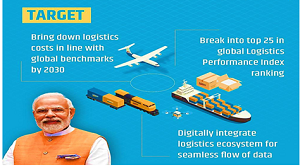National Logistics Policy
- 20 Sep 2022
On17th September, 2022, the government released the National Logistics Policy.
Vision
- To drive economic growth and trade competitiveness of the country through a truly integrated, seamless, efficient, reliable and cost-effective logistics network, leveraging best-in-class technology, processes and skilled manpower.

Key Objectives
- Creating a single point of reference for all logistics and trade facilitation matters in the country which will also function as a knowledge and information sharing platform
- Driving logistics cost as a % of GDP down from estimated current levels of 13-14% to 10% in line with best-in-class global standards and incentivize the sector to become more efficient by promoting integrated development of logistics
- Creating a National Logistics e-marketplace as a one-stop marketplace.
- Creating a data and analytics center to drive transparency and continuous monitoring of key logistics metrics
- Encouraging industry, academia and government to come together to create a logistics Center of Excellence, and drive innovation in the logistics sector
- Creating and managing on an ongoing basis, an Integrated National Logistics Action Plan which will serve as a master plan for all logistics-related development.
- Providing an impetus to trade and hence economic growth by driving competitiveness in exports
- Doubling employment in the logistics sector by generating additional 10-15 million jobs and focusing on enhancing skills in the sector and encouraging gender diversity
Policy Thrust Areas
- Focusing on critical projects to drive an optimal modal mix and to enable first mile and last mile connectivity
- Driving the development of Multi Modal Logistics Parks (MMLPs)
- Driving interventions to reduce logistics costs and promote logistics efficiency for the movement of key commodities
- Creating a single window Logistics e-marketplace
- Setting up a Logistics Data and Analytics Center
- Creating a Center of Trade Facilitation and Logistics Excellence (CTFL) and leveraging the expertise of multilateral agencies
- Creating an Integrated National Logistics Action Plan and aligning with respective state development plans
- Support strengthening of the warehousing sector
- Enhancing transport and rolling stock infrastructure
- Streamlining EXIM processes to promote trade competitiveness
- Reducing dwell time for interstate cargo movement by road
- Promoting standardization in the logistics sector
- Ensuring seamless movement of goods at Land Customs Stations (LCS) and Integrated Check Points (ICP)
Benefits
- The policy is expected to bring down the logistics cost, which is as high as 14-15 percent of India's GDP, to around 8 percent of GDP in the next five years.
- It will also provide a roadmap to reduce India's high dependence on road transport for cargo movement and switch to a mix of rail, shipping, road, and air transport.
- It will improve India’s trade competitiveness, create more jobs, improve India’s performance in global rankings and pave the way for India to become a logistics hub.




